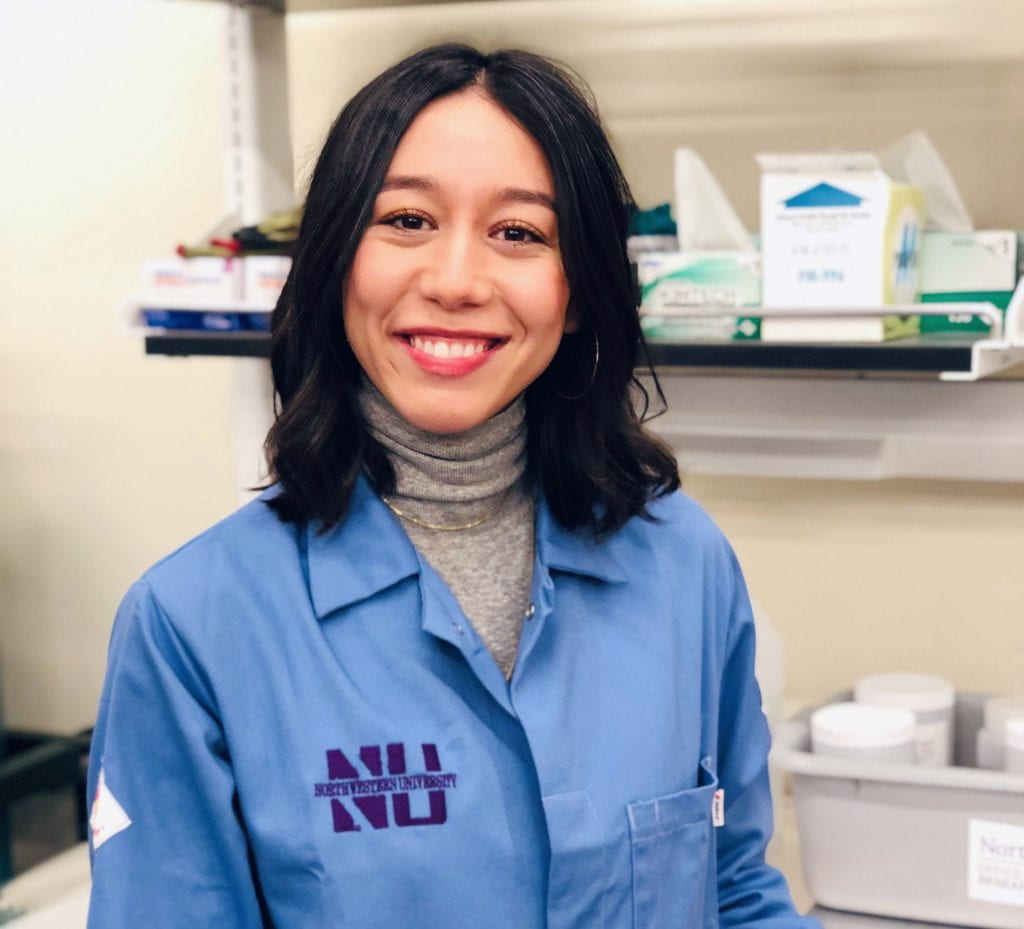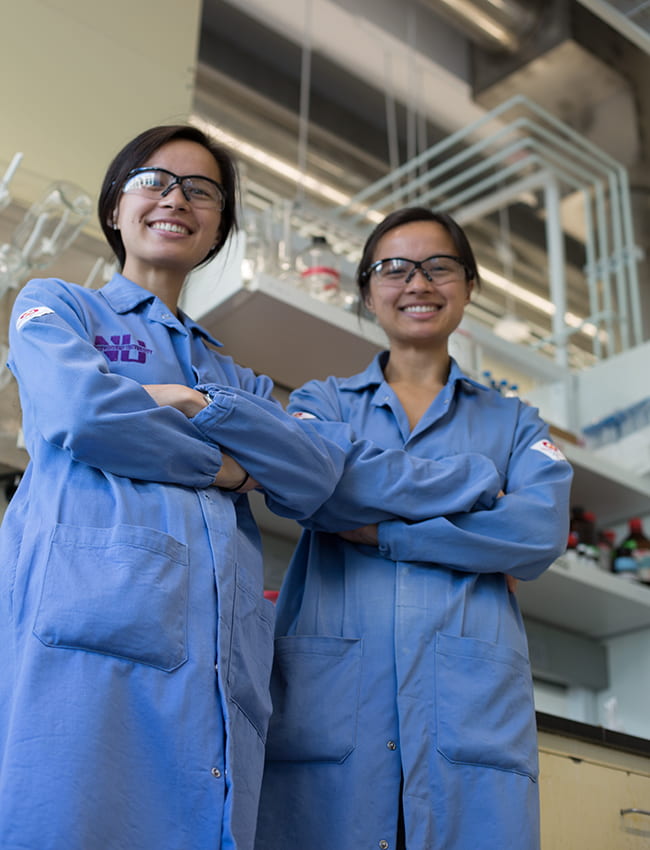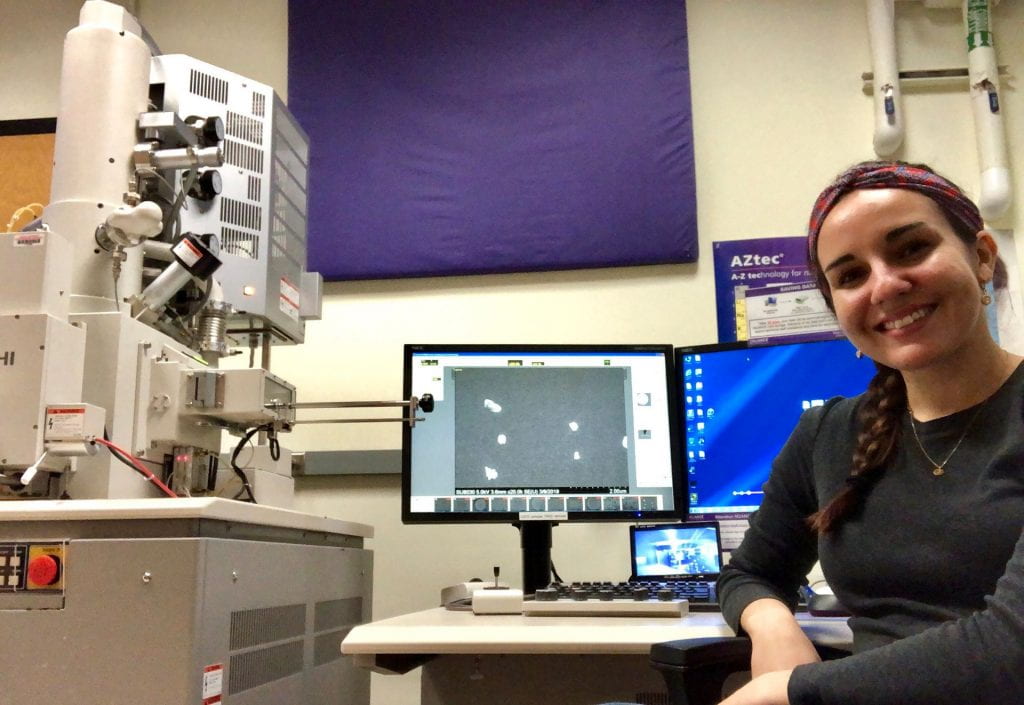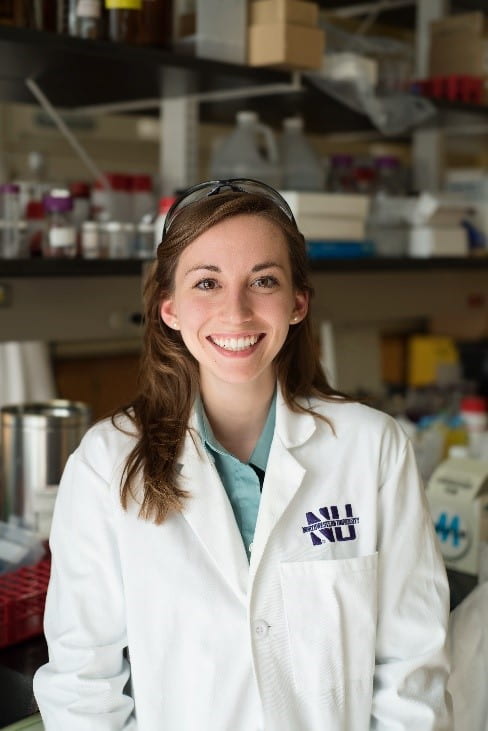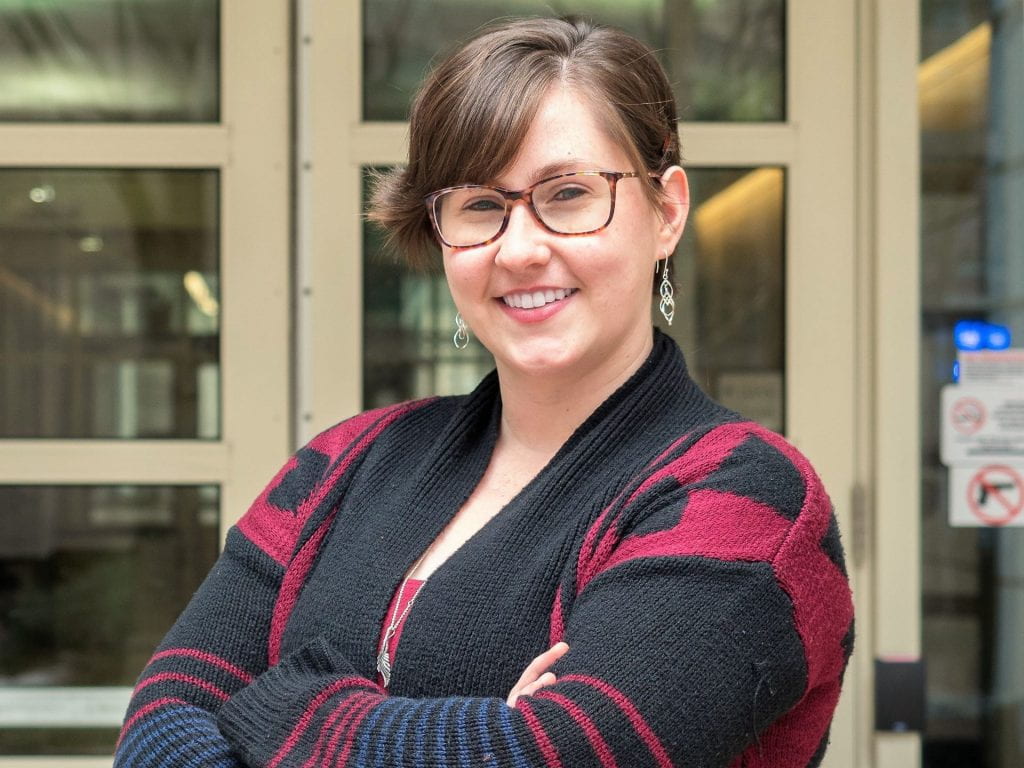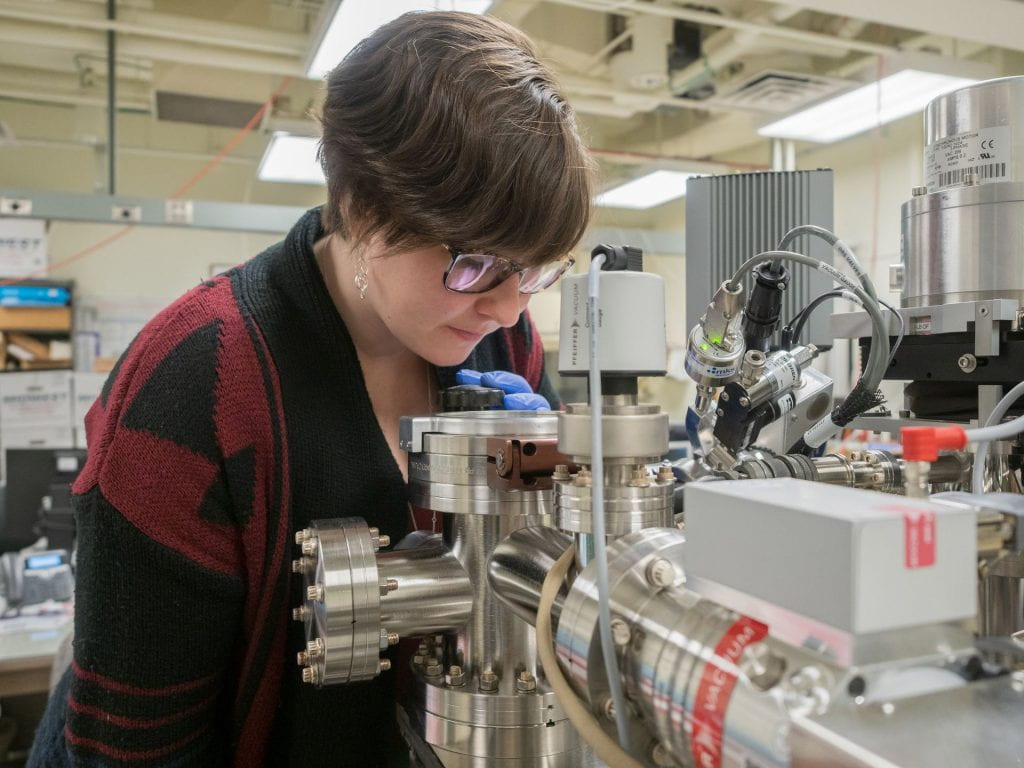SHyNE and NUANCE are honoring Women in History Month by recognizing female students who are sure to make a big impact on the field of studying tiny things!
Hadallia Bergeron
What inspired you to enter this field?
My high school physics teacher initially sparked my interest in quantum physics and nurtured my enthusiasm for science. He gave me the confidence to pursue a bachelor’s degree in physics. At that time, I started hearing a lot of buzz around a subfield called “nanoscience.” Once I started my studies at McGill University, I took a class on nanotechnology with another wonderful teacher, and from that point on I was determined to do nanoscience research! I love the intrigue of effecting big changes (macroscopic consequences) with the tiniest of tools (nanoscale components) and the manipulation of matter on an extremely unintuitive scale.
Describe your work/research.
My research focuses on the synthesis of atomically thin semiconductors for nanoelectronic applications. I use several vapor-phase methods to create high performance semiconductors that cover macroscopic areas but are only a single atom or few nanometers thick. In collaboration with my research group members, we exploit the ultrathin nature of the materials I synthesize to improve current technologies (e.g., transistors, photovoltaics), build novel electronic devices (e.g., memtransistors), and explore their potential in emerging fields such as valleytronics and neuromorphic computing.
What most excites you about nanoscience?
I love how nanoscience challenges my intuition and that there’s still so much to be explored. It’s exciting to be pushing the frontier of technology, and that most the science takes places in a regime we can’t see with optical microscopes, let alone our naked eyes. I am still fascinated when I run into the limits of our instrumentation and interpret that as a challenge to observe or “see” my material another way!
What are your interests outside of nanoscience?
I’m always on the lookout for a new hands-on creative outlet! Right now, I’m learning photography using a vintage 35 mm film camera. For the past few years, I’ve been into knitting and crocheting. I also love taking walks, whether it’s in Chicago with my greyhound Nike by my side, or in an entirely new city. Nothing compares to exploring a new neighborhood or city on foot and creating my own walking tour!
What other organizations are you involved in on campus?
I’m dedicated to making science more inclusive and approachable. Currently, I am a senior mentor for Science Club, where I guide weekly experiments with a group of middle school kids at the Pedersen-McCormick Boys & Girls Club in Chicago. In the past, I have served as Social Chair of the NU Graduate Society of Women Engineers (GradSWE) and co-founded the NU Materials Science Alliance for Inclusive Community (MatSAIC).
Anything else you’d like to share about yourself
I’m always open to chatting about my experience in academia and nanoscience research, especially from my perspective as woman-identifying. Feel free to reach out!
Andrea D’Aquino
What inspired you to enter this field?
I am fascinated and inspired by the world around me and seek to understand it through chemistry and nanoscience!
Describe your work/research.
My work is inspired by the unique properties and characteristics of biological systems, including molecular recognition, allosteric regulation and substrate-selective catalysis. These systems have motivated my research, which is focused on developing molecular, supramolecular and nano-scale architectures that incorporate such properties and evaluate them in the context of molecular sensing and catalysis.
What most excites you about nanoscience?
Nanoscience can help us to understand and explore matter on the molecular level. It allows us to study new phenomenon and develop new tools to solve some of the world’s greatest problems.
What are your interests outside of nanoscience?
Outside of nanoscience, I enjoy spending time outdoors. You may find me playing tennis, volleyball, running, kite flying or bird watching. I also love to volunteer my time to science outreach and, occasionally, explore space by re-watching Star Trek Voyager episodes. But perhaps one of my favorite things to do is spend time with my identical twin sister! Anne is in the Interdisciplinary Biological Sciences Program here at NU, and her work also relates to nanoscience (but is more bio-oriented), so we talk science a lot when we aren’t at work (and when we are at work) 🙂
What other organizations are you involved in on campus?
I am just as passionate about science as I am to outreach, diversity and inclusion. I helped establish programs such as HerStory and NU BonD (Northwestern University Building on Diversity) with a goal of promoting and supporting a scientific community built on inclusivity and diversity of thought, ideas, and backgrounds. I am also a volunteer with Science Club — an after school science program for middle school students — and have been incredibly fortunate to be involved with Northwestern’s Prison Education Program.
Anything else you’d like to share about yourself?
I study science to better understand the world around me and I hope to share the same curiosity and excitement I have for science, with others!
Julia Downing
What inspired you to enter this field?
My research experience was studying the optical properties of carbon nanotubes in Kyoto as part of the NanoJapan research experience for undergraduates. I was exposed to the highly collaborative nature of nanoscience across several disciplines (physics, chemistry, materials science and electrical engineering). I got hooked on studying the cool properties of my tiny structures and wanted to learn more!
Describe your work/research.
My work focuses on scalable manufacturing of 2D nanomaterials including graphene, boron nitride and molybdenum disulfide to enable formulation of nanomaterial inks that exhibit a range of electronic and functional properties. These inks can then be deposited by a range of different techniques including inkjet printing and 3D printing, which are getting a lot of attention for high-throughput fabrication of novel devices and structures. By exploring the properties of these nanomaterial phase spaces in a flow-based, scalable environment and testing their downstream properties with our lab’s printers, I am taking steps towards understanding and producing nanomaterials at the industrial level; this remains a challenge for bringing nanoscience-enabled solutions to solve engineering grand challenges without compromising material properties. I hope my work will contribute to the next generation of all-printed, flexible electronics that can be used for projects ranging from detecting contaminants in drinking water to revolutionizing energy storage.
What most excites you about nanoscience?
What excites me about nanoscience is that it intersects with so many different disciplines: medicine, energy, data storage, and even art benefit from ongoing research. The possibilities are limitless!
What are your interests outside of nanoscience?
I love running marathons, bouldering, traveling, catching up on my Netflix shows and doing nerdy things like playing Dungeons and Dragons with my friends.
What other organizations are you involved in on campus?
I am the incoming Vice President of the Graduate Society of Engineers (GradSWE) and served as treasurer for the past year previously! I also volunteer at the Pederson/McCormick Boys and Girls Club in Uptown Chicago as part of MSSA’s Junior Science Club.
Anything else you’d like to share about yourself?
I’m a GEM Fellow, and very passionate about increasing representation of women and minorities in science. This summer for my GEM fellowship I’ll be representing Northwestern by completing an internship at The 3M Company in Minneapolis, where I hope to gain industry insight on nanoscience research!
Allie Edelbrock
What inspired you to enter this field?
I started doing research in a biomaterials lab during my freshman year of undergrad at Case Western Reserve University. My research focused on making drug-delivering polymer nanospheres to treat spinal cord injury. I realized I was specifically passionate about nanoscience when I took my first SEM image of the nanospheres that I had spent weeks making. Oddly enough, to me, it was like seeing an ultrasound of a baby for the first time. I was so excited as the nanospheres came into focus, and I could see every detail of their surface. I still feel that excitement every time I sit down at the SEM.
Describe your work/research.
The focus of my research is to develop new biomaterial therapies for neural regeneration. After injury, the cells of central nervous system are unable to regenerate due to complex mechanisms that block regrowth. My research uses an injectable biomaterial, called the peptide amphiphile (PA), to address this multifaceted problem. PA molecules assemble into biocompatible and biodegradable nanofibers that form hydrogel scaffolds upon exposure to salts in the body.
In my research, I have developed a PA material that incorporates a neuronal growth cue, called brain derived neurotrophic factor (BDNF). BDNF induces survival, maturation and increased electrical activity of neurons. So far, we have shown that these BDNF PA nanofiber scaffolds improve neuronal growth in vitro, as well as hind-limb movement in a mouse spinal cord injury model.
What most excites you about nanoscience?
I still find it fascinating how small changes in materials and their properties can have such large effects on cellular bioactivity. In my work, I use a molecule that has no detectible effect on receptor activity by itself. As soon as I attach this molecule to a nanofiber, it can flick the biological switch in neurons that helps them grow, survive and send signals to other neurons.
Seeing these nanoscale phenomena under the microscope, I am firmly reminded of my passion for this field. Here is a gallery of some of the images I’ve taken over the years. I use microscopy as a creative outlet to connect my right and left brain.
What are your interests outside of nanoscience?
I enjoy spending time with my husband, Jack, and our two cats, Dexter and Amigo. To help me stay grounded, yoga and exercise are a big part of my life, and I have become involved in NUPose, a yoga club on the Chicago campus.
What other organizations are you involved in on campus?
When I was growing up, I was told that the only way to get a PhD was to get a job at a company that would sponsor me. It wasn’t until undergrad, when I was paired with a graduate student mentor, that I finally realized what it meant to get a PhD. This simple mentoring experience had such a large impact on my life, so I wanted to offer the same opportunity to undergraduates here at Northwestern. I started a mentoring program called “Graduates Mentoring Undergraduates.” We pair undergrads with graduate student mentors in their field for academic and career advice. It’s like a big brother big sister program. I hope to give back by advising other young scientists in the same way that encouraged me to keep reaching higher.
I’m also passionate about science advocacy, and I started a nonprofit 501(c)(3) organization called OpenScience DataBase with a fellow grad student. Our main goal is to help increase the public’s access to scientific publications by creating a centralized database of important scientific research taking place all around the world. Our editorial team works with scientists to summarize their published work in order to convert it to easy-to-understand language. In this way, we hope to expand awareness and understanding of science.
Anything else you’d like to share about yourself?
The best advice I can give fellow women in STEM, especially those thinking of beginning research, is that there will be many, many failures – and that’s ok. You will fall down seven times, but what matters is that you stand up eight.
Megan Hill
What inspired you to enter this field?
As a child I loved playing Rollercoaster Tycoon and decided I was going to build rollercoasters when I grew up. When the time came to apply to college, even though I was no longer interested in rollercoasters, I chose to pursue engineering because I liked math and science. In college I took an intro course to nanoscience, and was hooked ever since.
Describe your work/research.
I study the properties of nanowire semiconductor optoelectronics, with the goal to produce emitters for optical interconnects to replace copper wires in microelectrons. Similar to how fiberoptics have greatly improved our long range information transfer, these interconnects would consume less power and greatly speed up information processing within electronics. I focus on understanding the nanoscale strain and composition variations that may occur within the nanowires, because these variations can modify the emission. This means I need to utilize a large array of nanoscale characterization techniques like electron microscopy, x-ray imaging, and atom probe tomography.
What most excites you about nanoscience?
I love being able to push the limit of what we can observe, looking inside structures and seeing what they are composed of on the nanoscale.
What are your interests outside of nanoscience?
I like cooking, crafting, and watching TV. I also love hanging out with my roomates and visiting my nieces.
What other organizations are you involved in on campus?
I was previously on the board of the Materials Science Student Association, and I am currently on the board of the Society of Women Engineers – Graduate Division at NU.
Anything else you’d like to share about yourself?
I would like to continue studying nanoscience, first by pursuing a postdoc, with a goal of improving synchrotron-based x-ray imaging techniques for investigating nanoscale strain in materials.
